Our world is getting hotter. Summer heatwaves are so frequent, they’re stretching the bounds of what we think of as summer. Hot-and-bothered home working and sweaty, sleepless nights are now alarmingly common.
Fans sell out when the mercury rises, so get ahead of the pack by ordering one in anticipation: there will always be another heatwave. Get a good fan, and you can also dodge the temptation of air conditioning. Air con is incredibly effective, but it uses a lot of electricity … and burning fossil fuels is how we got into this mess in the first place. Save money and carbon by opting for a great fan instead.
Fans are much more energy efficient than air con. A typical portable air conditioner uses 1000W of electricity, which would cost about 26p an hour to run from 1 July, when the energy price cap changes to 25.73p/kWh. The fans I tested used between 8W and 60W; my favourite, the AirCraft Lume, used 18W on its top setting. You could run it on max for 56 hours, and it would still use no more electricity (money, carbon) than a single air con unit going for an hour.
I tested 14 fans of all shapes and sizes, so you can pick the best one for you. I tested them for size, noise, power use and, of course, how much they cool you down. I also tested a few “evaporative coolers”, which use water to cool the air blowing at you while using significantly less energy than air con.
At a glance
-
Best fan overall:
AirCraft Lume
£129 at AirCraft -
Best budget fan and best desk fan:
Devola desk fan
£49.99 at Devola -
Best tower fan:
Dreo Cruiser TF518
£89.99 at Amazon -
Best travel fan:
Morphy Richards Air Flex USB fan
£39.99 at Morphy Richards -
Best evaporative cooler:
Swan 5-litre Nordic air cooler
£69.99 at Swan
Why you should trust me
I’m an award-winning consumer tech journalist with decades of experience testing gadgets. I’m also a menopausal woman in her 50s who honestly can’t remember the last time she felt cold: I think that might be why we gravitate to wild swimming in middle age. Oh, and I have a degree in engineering. So I’m triply qualified to put these fans through their paces, scientifically and subjectively.
How I tested

I chose 14 fans, each from different brands, aiming for a mix of new and highly rated models plus a few stellar bargains. I wanted to make sure there was something for everyone before I put them through their paces.
I used a power meter to measure how much electricity (and therefore money and carbon) the fans use, an anemometer to measure the air speed they generate on the top setting, and the Sound Meter app to measure the noise on the top setting (they were all too quiet to register on their lowest).
I measured everything from 1m away, although in reality, you’ll probably position a tower or pedestal fan farther away and a desk fan closer to you. That means the noise a desk fan makes matters more.
I also measured them myself, as sometimes the official specs can be misleading or wrong. For example, I measured a tower fan that was supposedly 17cm wide, only to find that wasn’t including the base. Here I’ve stuck with each fan’s largest dimensions, including their footprint.
I used a thermometer to measure the impact of the evaporative coolers I tested, and took note of everything from how cooling each of the fans felt, how annoying the noise was and how good the controls were. I also considered how they looked and how small they packed away, as well as the price tag.
All the fans that weren’t returned to the manufacturers were donated to Furnishing Futures, a charity that furnishes the empty social homes in which women and children are placed after domestic abuse.
The best fans in 2025
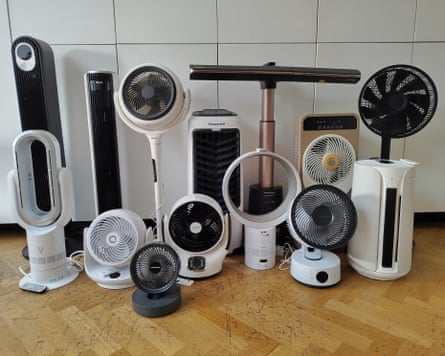
Best fan overall:
AirCraft Lume
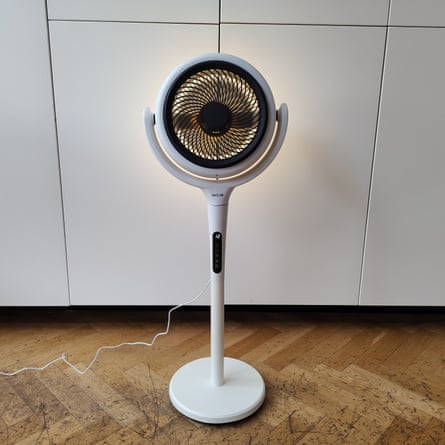
This pedestal fan was hard to fault, with an elegant design that boasts a dimmable backlight (three brightness levels or you can turn it off, all with the remote control). It’s billed as height adjustable, but rather than scooting up and down, you can remove the bottom pole to convert it into a 63cm desk fan. There’s an LED display and touch controls on the front, and other features include a 12-hour timer and a sleep mode. In fact, of all the fans I tested, this one is probably the best for sleeping: alongside the sleep mode, it is the best for low noise relative to wind speed.
Why we love it
I loved the AirCraft for many reasons. It’s light but with a reassuringly heavy base, giving it Weeble-like stability: it’s difficult to knock over. It packs away pretty small for the winter because the pole comes apart. I also liked that the packaging is almost plastic-free.
It oscillates both horizontally and vertically, so it can circulate air nicely around a whole room. Most importantly of all, this fan can really shift air – its 5.9m/s (metres a second) was the best on test, and you can really feel it. When the heatwave hits, this is what you want. All for a reasonable price, too.
It’s a shame that … there’s nowhere to stow the remote control when it’s not in use.
Style: pedestal (or desk)
Dimensions: 37 x 28 x 95cm (WDH)
Number of speeds: 12
Remote control? Yes
Peak noise level on test: 55dB
Power use on top setting: 18W
Air speed on top setting: 5.9 metres per second
Best budget fan and best desk fan:
Devola desk fan

£49.99 at Devola
£49.99 at AirconCentre
This affordable desk fan punches well above its weight, with good features and powerful airflow. It has a display, touch controls, a remote, a timer and sleep mode. You can choose vertical oscillation (90 degrees), horizontal oscillation (80 degrees) or use both to circulate the air in a room. Not bad for a humble desk fan.
Why we love it
It’s a bargain powerhouse, producing a substantial wind. I measured an air speed of 4m/s, which was one of the best on test. It certainly felt cooling.
I couldn’t hear the Devola on the first three of its nine speeds, and even when the noise got louder on higher settings, it wasn’t too annoying.
It’s a shame that … the display is on the base facing upwards, so you can’t see it unless you’re nearby. There was no instruction manual in the box, either, although I found it straightforward to use.
Style: desk
Dimensions: 30 x 21 x 31cm (WDH)
Number of speeds: 9
Remote control? Yes
Peak noise level on test: 50dB
Power use on top setting: 16W
Air speed on top setting: 4.0m/s
Best tower fan:
Dreo Cruiser TF518

£89.99 at Amazon
£109.99 with wifi voice control at B&Q
This tower fan is slim but striking in black. Features include 90-degree oscillation, a 0- to 12-hour timer, a sleep mode where the fan speed decreases gradually, and an auto mode that adapts the fan speed depending on the room temperature.
Why we love it
At full blast, the Dreo felt positively windy and was definitely cooling on a hot day. On the two lowest settings, no sound was audible, but I could still feel a gentle breeze. I also liked the recess at the top-back that makes it easy to carry with one hand.
It’s billed as a “25dB silent bladeless fan”, but I measured 60dB on top whack from a metre away. The sound wasn’t too annoying, though, and the fan’s powerful cooling made it forgivable.
It’s a shame that … its energy consumption is relatively high. We’re talking pennies in electricity, but still, energy efficiency is good. Also, there’s nowhere to clip the remote control.
Style: tower
Dimensions: 32 x 32 x 106cm (WDH)
Number of speeds: 9
Remote control? Yes
Peak noise level on test: 60dB
Power use on top setting: 29W
Air speed on top setting: 3.6m/s
Best travel fan:
Morphy Richards Air Flex USB fan
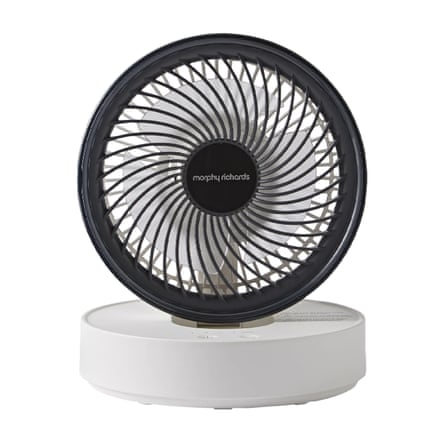
£39.99 at Morphy Richards
£39.99 at Ryman
This is the fan you can take with you anywhere. I don’t mean to fan yourself by hand: it folds down small and it’s cordless and USB rechargeable, so you can be the smuggest person on the train and a very happy camper on a hot day. It can also give you a breeze on a still day on the patio. The battery will last from four to 17 hours, depending on fan speed. And you can plug it into a laptop at your desk or even a power bank for more juice.
Why we love it
The 2.6m/s air speed can’t compete with the big fans on test – but it’s not trying to. It’s an electric fan that can go anywhere, folding down to a cylinder measuring 18 x 18 x 12cm. You can even hang it on the wall, if you wish.
There’s no timer or sleep mode, but there’s a “nature mode” that varies the speed to mimic a breeze. And it does oscillate (to 90 degrees). It’s also quiet: I couldn’t hear it on the first of its three speeds, and it was never loud enough to be annoying.
It’s a shame that … air speed dips slightly when it’s not plugged in, but only slightly (2.5m/s instead of 2.6m/s)
Style: desk
Dimensions: 18 x 18 x 22cm (WDH)
Number of speeds: 3
Remote control? No
Peak noise level on test: 35dB
Power use on top setting: 8W
Air speed on top setting: 2.6m/s
Best evaporative cooler:
Swan 5-litre Nordic air cooler

£69.99 at Swan
£69.99 at Amazon
The air speed may not be great, but this Swan model is still a good buy because it’s an evaporative cooler, meaning it uses water from its five-litre reservoir to cool the air it blows at you. It can be used as a regular fan, too. Evaporative coolers are much more energy-efficient than air conditioning, so they use much less power (and therefore less carbon, assuming you’re not on a renewable tariff or producing your own electricity).
Why we love it
Of the two evaporative coolers I tested, this worked the best. I could see the temperature on the thermometer go down: it cooled by more than 1C in less than 30 minutes. And it felt like a cooling breeze. In fact, it felt a bit like air con.
I just filled it with water, but it comes with two ice packs that you can pre-freeze and throw into the reservoir for even colder results.
The breeze felt wide, rather than focused. This is a question of personal taste: some people want a powerful fan that’s focused to blast just them, while others prefer a room-filling breeze. In oscillating mode, it’s wider still, as the grille at the front rotates, which is a bit hypnotic. It’s good-looking, too, in a coffee-coloured oatmeal or grey finish. It’s light and on casters, so easy to move around, and its modes include normal, natural, sleep and timer.
It’s a shame that … you can hear the water in the pipes: it sounded like a leak. You might even find yourself needing the loo.
Style: tower
Dimensions: 29 x 24 x 71cm (WDH)
Number of speeds: 24
Remote control? Yes
Peak noise level on test: 45dB
Power use on top setting: 26W
Air speed on top setting: 0.9m/s
The best of the rest
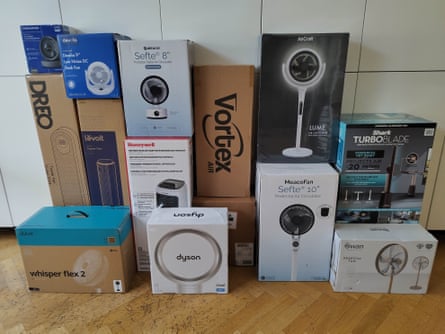
Levoit classic tower fan
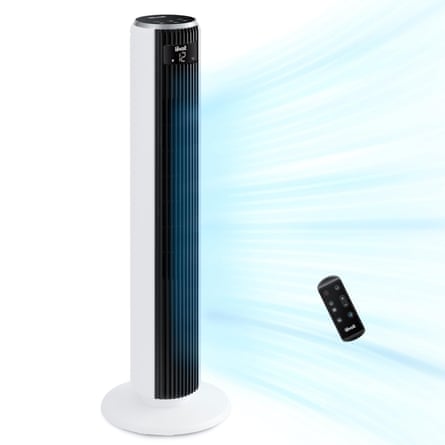
Best for: a quieter tower fan
This produces a narrow beam of air, so you need to point it at you just right or set it to oscillate (90 degrees). It’s billed as a “20dB silent tower fan”, and it’s inaudible on the lowest four of its 12 speeds, but it was considerably louder at top whack.
It’s good-looking, and I liked the space in the back to stow the remote control. There’s a 12-hour timer and a sleep mode, too.
It didn’t make the final cut because … for the same price, the Dreo is more powerful, which is what you need on a really hot day.
Style: tower; dimensions: 29 x 29 x 92cm (WDH); number of speeds: 12; remote control? Yes; peak noise level on test: 50dB; power use on top setting: 40W; air speed on top setting: 1.7m/s
Vortex Air Pro Plus

Best for: style, and its all-in-one heater and fan design
Vortex Air bladeless fans look modern, very Dyson-esque, and this one comes in 10 colour combos. It’s useful year-round, too, doubling as a fan heater. But it’s hard to categorise: too short for a tower fan, too tall for a desk fan.
There’s a timer and it oscillates horizontally (71 degrees) and vertically (180 degrees), though it’s hard to imagine why you’d want to point it completely down. The touch controls are at the base, which isn’t very practical if it’s on the floor, and the display was a bit hard to see.
It didn’t make the final cut because … I found the noise a bit annoying; I could hear it at levels 2-10.
Style: tower; dimensions: 25 x 24 x 65cm (WDH); number of speeds: 10; remote control? Yes; peak noise level on test: 35dB; power use on top setting: 28W; air speed on top setting: 2.9m/s
Honeywell 10-litre evaporative air cooler

£74.99 from AirconCentre
£79.99 at B&Q
after newsletter promotion
Best for: a quiet evaporative cooler
A chunky tower fan with an extra skill: you can turn on evaporative cooling, using water to cool down the air it puts out. Its swing mode moves horizontally, and you can manually move the grilles to angle the air up or down. It’s on casters, too.
I liked its large (10-litre) water capacity and how quiet it was, but the fan wasn’t strong enough, and the evaporative mode wasn’t cold enough. I tried it several times, and in half an hour, it never managed to cool the area in front by a degree.
It didn’t make the final cut because … it didn’t cool the room down enough.
Style: tower; dimensions: 31 x 30 x 75cm (WDH); number of speeds: 3; remote control? Yes; peak noise level on test: 30dB; power use on top setting: 39W; air speed on top setting: 1.8m/s
Shark TurboBlade TF200SUK

Best for: pointing in two directions at once
This bladeless fan’s unusual T-shaped design has arms that stick out left and right, each putting out air, or you can turn them by 90 degrees for a tall, thin fan. You can angle each arm independently, good for pointing at two people. It’s height-adjustable and can oscillate (180 degrees) horizontally too. I liked that the remote attaches to the top with a strong magnet.
It’s powerful, but the sound is very annoying: it sounds like a vacuum cleaner, and I wanted it to stop. It also used the most power on test; even still, a 60W fan costs less than 2p an hour to run at the current energy price cap, so it’s pennies compared with air con.
It didn’t make the final cut because … I hated the noise it makes.
Style: pedestal; dimensions: 80 x 30 x 78-95cm (WDH), or 124 x 30 x 114-130cm in vertical mode; number of speeds: 10; remote control? Yes; peak noise level on test: 35dB; power use on top setting: 60W; air speed on top setting: 3.1m/s
Duux Whisper Flex 2

£179.99 at Duux
£179.99 at Amazon
Best for: smart controls
This took quite a bit of assembly, but it’s good-looking, can be converted into a 54cm-high desk fan by removing a pole, and the tech is clever too. You can control it with an app or by voice (Amazon’s Alexa or Google Assistant) to set up to seven schedules. There’s an optional battery and charging dock to make it cordless.
It’s fairly quiet and oscillates well, vertically and horizontally, but I found the standard controls annoying. The display on the base points upwards, so it’s hard to see from across the room, and you have to point the remote very accurately at it.
I did like the compostable packaging. But unusually, it drew far too much power (2W) on standby. Less than 1W is the norm.
It didn’t make the final cut because … of the annoying controls.
Style: pedestal; dimensions: 34 x 34 x 92cm (WDH); number of speeds: 30; remote control? Yes; peak noise level on test: 40dB; power use on top setting: 9W; air speed on top setting: 3.1m/s
VonHaus air circulator desk fan

£49.99 at VonHaus
£64.99 at The Range
Best for: room-filling breeze
This desk fan has a display and touch controls on the front. And it oscillates well: it turns 90 degrees vertically, 80 degrees horizontally or both together to create a room-filling breeze. I couldn’t hear the lowest five of its 12 speeds, either.
It looks good, and the controls are easy to use. Features include a one to 12-hour timer and a sleep mode that decreases fan speed every 30 minutes through the night.
It didn’t make the final cut because … I liked the Devola desk fan even more, but this is a solid buy too.
Style: desk; dimensions: 30 x 21 x 36cm (WDH); number of speeds: 12; remote control? Yes; peak noise level on test: 45dB; power use on top setting: 13W; air speed on top setting: 2.7m/s
Dyson Cool CF1

£249 at John Lewis
£249.99 at Dyson
Best for: looks and design
You can see a lot of thought has gone into the CF1’s design. Not just its simple, circular air multiplier, but every single detail. The display is small but very readable. The oscillation (15, 40 or 70 degrees) works well. The magnetic storage on top for the remote control is clever. The controls work well and let you easily set the timer and sleep mode.
I couldn’t hear this bladeless fan on the first six of its 10 speeds, and I found the noise easy to live with even at higher speeds.
It didn’t make the final cut because … the price is hard to justify. Money no object? Go for it!
Style: desk; dimensions: 36 x 16 x 55cm (WDH); number of speeds: 10; remote control? Yes; peak noise level on test: 35dB; power use on top setting: 20W; air speed on top setting: 2.9m/s
Meaco Sefte 8in portable air circulator

Best for: a cordless fan
This is an impressive, new cordless desk fan with a battery life of four to 17 hours, depending on fan speed. I couldn’t hear the first seven of its 12 speeds. It oscillates and you can manually point it up or down, and features include a timer, night and eco modes. Its three-year warranty is a bonus, too (most have two).
Overall, I liked it. It’s good-looking and pretty strong, although it’s weaker when cordless; for example, air speed dropped from an impressive 4.6m/s to 3.1m/s when I unplugged it. Still, if you want a desk fan that can sometimes be cordless, it’s a good buy.
It didn’t make the final cut because … the USB-powered Morphy Richards is even handier.
Style: desk; dimensions: 26 x 20 x 38cm (WDH); number of speeds: 12; remote control? Yes; peak noise level on test: 55dB; power use on top setting: 10W; air speed on top setting: 4.6m/s
Blueair ComfortPure 3-in-1 T20i

Best for: hay fever and allergy sufferers
This is also a fan heater (so it’s useful all year round) and an air purifier (ideal for allergy sufferers). It cleans the air in a room in 12.5 minutes or a small house in an hour, removing airborne particles such as pollen, odours, dust and smoke.
On test, it created a good breeze, even though the anemometer only read 0.8m/s. And on cooler days, it can send purified air upwards instead, circulating air in the room as well as cleaning it.
The controls and display are on top, making them hard to see from across the room. But there’s an app and Alexa control as well as a remote. The three-year warranty is nice, too.
It didn’t make the final cut because … it’s expensive as a fan (but great as an air purifier).
Style: tower; dimensions: 24 x 24 x 50cm (WDH); number of speeds: 4; remote control? Yes; peak noise level on test: 35dB; power use on top setting: 21W; air speed on top setting: 0.8m/s
What you need to know

What is a bladeless fan?
Bladeless fans aren’t magic; they just don’t have visible blades. The work is done inside the body of the fan, and then air is pushed out of a nozzle. The Dyson, Vortex Air and Shark above are all bladeless. They look modern and are easy to clean. And there are no moving parts on show, so zero chance of getting your hair caught.
What does oscillation mean?
Most fans oscillate (move back and forth) by swivelling on their base, and some let you select how wide an the angle you want. If it’s just for you, pick a narrow angle; if you’re cooling the whole office, go wide. Some fans achieve the same effect in other ways, such as by moving louvres. And some oscillate up and down too, so the fan can circulate air all over the room to create a gentle breeze.
What’s sleep mode?
Most fans have a sleep mode, where every 30 or 60 minutes the fan lowers its setting until it reaches a certain point. This is a good compromise that helps you get to sleep without wasting energy, minimising the risk of waking up in the middle of the night suddenly cold.
Start by lowering the fan speed to the point where you don’t find it annoying. In fact, some people find the white noise of a fan helpful at bedtime. Then use sleep mode.
Where is the best place to position a fan?
For personal comfort, simply point it towards you. The cooling feeling is because the moving air from the fan displaces the warm, humid air near your skin, which in turn helps your sweat evaporate, cooling your body down. It’s like a breeze rather than a still day. Or why it feels colder swimming in a river than in a lake, even if the water temperature is the same. Evaporative coolers, of which I’ve included two above, use water to actively cool the air.
Never place a fan up against a wall because there needs to be air flowing into the back. If the air’s cooler outside, put the fan in front of an open window or door to bring in the cooler air.
How much does a fan cost to use?
I’ll set out the maths. For each fan here, I’ve measured its power use on the top setting, in watts (W). Electricity costs are in kilowatt hours (kWh). If, for example, you were using a 30W fan for five hours, it would use 150Wh. Divide by 1,000 to convert it to kilowatt hours: 0.150kWh.
The energy price cap for 1 July to 30 September 2025 is 25.73 pence per kWh. Multiply this by the last figure and you’ll discover it will cost just under 4p to run that fan for five hours. Or £14 to run it for five hours every day for a year.
Running fans is pretty cheap, then, and a good fan will keep you cool enough to dodge buying any kind of air conditioning. An evaporative cooler is a good alternative to air con. The two I tested used 26W (Swan) and 39W (Honeywell), so they use less than 3% of the electricity of a typical portable air conditioner (1000W). The effect isn’t the same: you can’t turn your bedroom into a fridge. But you can cool the air enough to make a big difference when there’s a heatwave.
Do I need air conditioning?
If you’re in the UK, honestly, no. It’s tempting to turn your bedroom into a walk-in fridge on a hot day, but fans are great and use much less electricity (and therefore money and carbon) than air con. Unless you’re on a renewable tariff, electricity use accelerates climate breakdown.
Caramel Quin is a journalist specialising in consumer technology. She prides herself on real-world testing and plain language. Her pet hates are jargon, pointless products and overcomplicated instruction manuals. Caramel is an engineering graduate who has won awards for communicating hi-tech subjects to normal people. When she’s not testing gadgets, she’s feeding pets (16 beasts at the time of writing) or pottering at the allotment

 3 months ago
78
3 months ago
78

















































